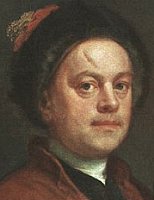
|
Hogarth was born in London on November 10, 1697. On finishing his apprenticeship to a silversmith in 1718, he turned to engraving and first became known in 1726 for his illustrations for the novel Hudibras (1726), by Samuel Butler. Hogarth began painting about 1728, producing small group scenes such as A Musical Party (1730?, Fitzwilliam Museum, Cambridge). By 1735 he had established a reputation as a painter of English manners and customs by two series of paintings, A Harlot's Progress (1731-1732, destroyed by fire in 1755) and A Rake's Progress (1735, Sir John Soane's Museum, London). Through the sets of engravings he made from these paintings, Hogarth gained renown as a brilliant satirist of moral follies. Plagued by the artistic piracy to which his popular engravings were subject, he secured the passage of a copyright act, often called Hogarth's Act, in 1735.
Two of Hogarth's most ambitious, although least characteristic, works are the murals The Good Samaritan and The Pool of Bethesda painted on the staircase of Saint Bartholomew's Hospital, London, from 1735 to 1736. These murals were executed in the so-called grand manner, a highly ornamental, baroque style depicting mythological subjects; it was popular in the French and Italian art of the period. In 1743 Hogarth completed the six paintings entitled Marriage Á la Mode (National Gallery, London); in 1745 the engravings based on these paintings were published. Hogarth's remarkably exuberant satire of marriage for money, his pungent details of upper-class life, and his mastery of complex scenes find perhaps their highest expression in this series, generally considered his finest work. To this period also belong many of Hogarth's portraits. Among his exceptional portraits are the famous Garrick as Richard III (1745, Earl of Feversham Collection) and The Shrimp Girl (1759?, National Gallery, London).
In 1753 Hogarth wrote The Analysis of Beauty, a statement of his aesthetic principles. Four years later he was appointed sergeant painter to George II. During the last five years of his life, Hogarth was engaged in political feuds with the controversial British political reformer John Wilkes, whom he had satirized in an engraving. Wilkes retaliated with an attack on Hogarth's painting Sigismunda (1759). Hogarth's last engraving, The Bathos, intended as a farewell work, was published in 1764. He died in Chiswick on October 26, 1764. On his monument is an epitaph written by his friend, the actor David Garrick.
|

